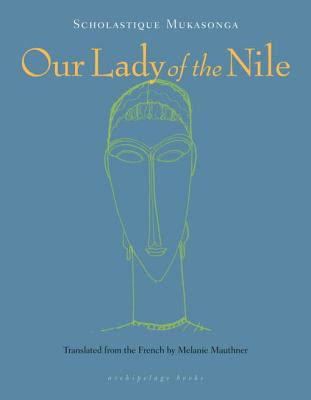7.4 /10 1 Votes7.4
Originally published 2012 | 3.7/5 Goodreads | |||||||||||||||||||||||||||||||||
 | ||||||||||||||||||||||||||||||||||
Similar Dans le nu de la vie, The Sermon on the Fall of, Machete Season: The Killer, A Sunday at the Pool in Kigali, Plague and Cholera | ||||||||||||||||||||||||||||||||||
Our Lady of the Nile (French: Notre Dame du Nil) is a French-language novel by Scholastique Mukasonga, originally published in 2012 by Éditions Gallimard. It is Mukasonga's fourth book and first novel. The English-language translation, published in the United States in 2014 by Archipelago Books, was done by Melanie Mauthier, a poet and writer from the United Kingdom.
Contents
The story is about life at a Catholic boarding secondary school in Nyambinombe District, Rwanda circa 1980, prior to the Rwandan Genocide of 1994.
Christine Rousseau of Le Monde wrote that "D'une écriture âpre et tendue, Notre-Dame du Nil dépeint une société qui chemine inexorablement vers l'horreur" ("With bitter and tense writing, Our Lady of the Nile depicts a society walking inexorably towards horror"). Brian P. Kelly of The New Criterion wrote that the book "is a snapshot of the social and racial conflicts that eventually led to the 1994 massacres." Madeleine LaRue of Music & Literature wrote that "The West has indeed too often dismissed suffering in Africa, but books like Our Lady of the Nile remind us why we must not be dismissive, why we must not look away."
Story
The story takes place at an all-girls lycée at the top of a hill, near the source of the Nile River. The story is set during Hutu rule. The school has a quota that limits Tutsi students to 10% of the student body. The characters form an ensemble cast and are present throughout the book. Each chapter focuses on a particular girl. The middle of the novel includes the Tutsi students' encounters with some men, and the final portion of the novel showcases an anti-Tutsi frenzy. Character deaths are not directly depicted and are instead recounted by another character.
Tom Zoellner of Chapman University argued that the beginning of the novel is "too preoccupied with stage-setting".
Style
Christopher Byrd of Barnes & Noble Review stated that the novel uses a context leading up to the Rwandan massacre while also maintaining "a universal texture to the resentment, envy, and opportunism that are a part of any student body" through being a school story. Nick DiMartino wrote in Three Percent that Mukasonga included "chuckling good humor" and was "playful" in her writing. The novel uses many Kinyarwanda words, a feature retained in the English translation; LaRue stated that many writers in post-colonial countries intersperse words of indigenous languages into texts written in European languages, which is "interrupting" the colonial language. The English version also retains usage of some French words, such as lycée, giving it what LaRue describes as "another layer of “foreignness” to the text."
Characters
Publishers Weekly wrote that the characters are distinct and that a few characters "lack overt motivation for their nastiness". LaRue argued that some characters are "too schematic".
Most of the characters are schoolgirls from wealthy families. Students include:
Faculty:
Other characters:
Reception
The book won the 2012 Ahmadou Kourouma Prize. It also won the Prix Renaudot, the French Voices Award, and the Océans France Ô prize. Judith Rosen of Publishers Weekly ranked it as one of "The Big Indie Books of Fall 2014".
Byrd stated that the "air of foreboding consequence that imparts urgency to almost every page" adds to the novel, and that "Mukasonga is a gifted storyteller with a sure sense of plot construction, and an aptitude for crafting piquant descriptions." Byrd criticised the use of archetypes as characters, calling them "tendentious characterizations" and Byrd also argued that the dialog "skews too much to blatant declarations for my tastes".
Rousseau wrote that the book was "Poignant et implacable" (poignant and harsh/implacable).
Tom Zoellner of Chapman University stated that the book is an "outstanding work of African fiction", and that "Mukasonga is dead on target about Rwanda". According to Zoellner, the expository speeches were "clunky" and some characters made "stentorian proclamations that no self-respecting adolescent girl would attempt" and therefore "Mukasonga’s strength is generally not in dialogue."
LaRue stated that "we should[...]welcome the opportunity to read Mukasonga’s work in English", despite its minor flaws including " dialogue and exposition[that]are occasionally clumsy".
John Taylor wrote in The Arts Fuse that Our Lady of the Nile is "well-constructed". He argued that the author used too pedagogical of an approach to explain the Hutu-Tutsi conflict but he said that was a minor complaint.
Publishers Weekly wrote that Mukasonga "fully draws readers into the tensions, spirituality, and culture of Rwandan life from page one."
